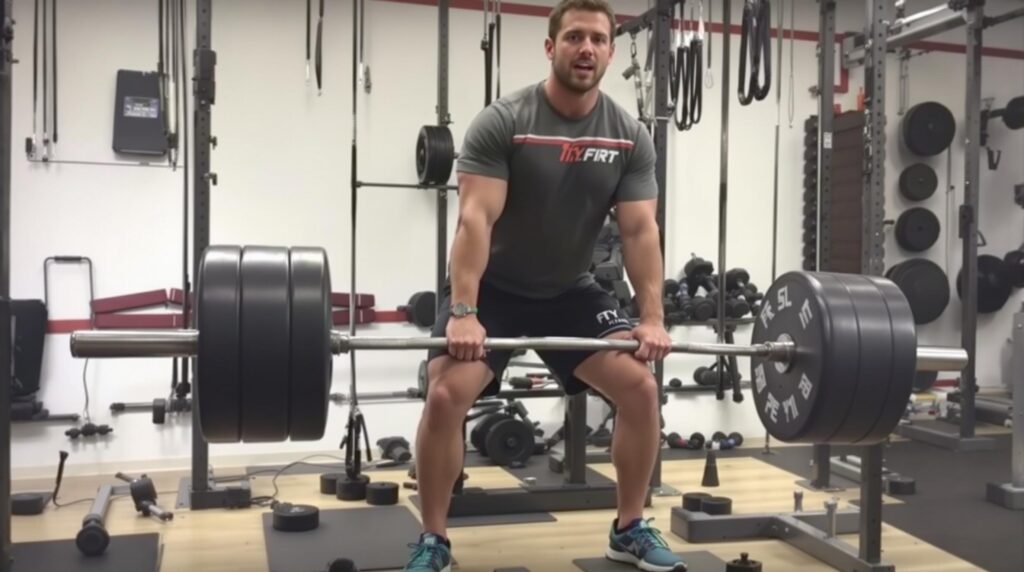Dumbbell deadlifts combine the strength-building potential of conventional deadlifts with the accessibility and versatility of dumbbell training. These compound movements activate multiple muscle groups simultaneously, making them an efficient exercise for developing posterior chain strength, improving stability, and enhancing functional performance in everyday activities.
Key Takeaways
- Superior muscle activation in the gluteus maximus (105-168% activation) and hamstrings during dumbbell deadlifts
- Dumbbell deadlifts offer comparable benefits to barbell variations with added stabilization demands
- Proper form includes neutral spine positioning and effective hip hinge mechanics to prevent injury
- For optimal hypertrophy, perform 3-5 sets of 6-12 reps with progressive overload
- Beginners should start with 25 pounds per hand and focus on technique before increasing weight
The Science Behind Dumbbell Deadlifts
Dumbbell deadlifts target multiple muscle groups simultaneously, making them an extremely efficient compound exercise. According to research from Mo et al. in 2023, the superior gluteus maximus shows impressive activation levels between 105.4-168.6% during proper deadlift execution. The biceps femoris (part of the hamstring group) demonstrates 69.6-122.4% activation, while the erector spinae and core stabilizers work continuously throughout the movement.
What makes dumbbells deadlifts particularly valuable is their functional carryover to daily activities. The hip hinge pattern mimics movements like picking up objects from the floor, lifting groceries, or picking up children—making it directly applicable to everyday life. Studies show no significant difference in gluteus maximus or hamstring activation between dumbbell and barbell variations, suggesting that dumbbells offer comparable training benefits while being more accessible for home workouts.
The biomechanical advantages for posterior chain development make dumbbell deadlifts suitable for both competitive athletes and fitness enthusiasts. Their ability to develop functional strength while allowing for natural movement patterns makes them a staple in any comprehensive strength training program.

Mastering Proper Form: Step-by-Step Technique Guide
Proper form is absolutely critical for both effectiveness and safety during dumbbell deadlifts. Research indicates that 87% of powerlifters report injuries linked to poor deadlift form, with rounded backs being the primary culprit. To avoid joining these statistics, follow this step-by-step guide:
1. Begin with dumbbells placed on the floor just outside your feet
2. Stand with feet hip-width apart, toes pointed slightly outward
3. Hinge at the hips by pushing your buttocks backward while maintaining a neutral spine position
4. Bend your knees slightly until you can grasp the dumbbells
5. Engage your lats by visualizing “squeezing oranges in your armpits”
6. Drive through your heels and push the floor away, maintaining a flat back
7. Finish by squeezing your glutes at the top position without hyperextending
8. Return to starting position by reversing the movement, leading with the hips
Common form cues that help maintain proper technique include “spread the floor with your feet” to reduce knee valgus and “drive your hips and chest together” for optimal bar path control. These mental cues create better movement patterns and reduce injury risk.
For beginners, starting with approximately 25 pounds per hand is recommended according to Trotta. This allows for technique mastery before progressing to heavier loads. Remember that approximately 70% of powerlifters experience training-related injuries, often during deadlifts, so prioritizing form over weight is essential for long-term progress.
Dumbbell vs. Barbell: When and Why to Choose Dumbbells
While barbell deadlifts are often considered the gold standard for maximum strength development, dumbbell variations offer distinct advantages in certain scenarios. Understanding these differences helps make informed training decisions:
Range of motion is one significant difference, with dumbbells allowing 10-15% deeper hip flexion since they can travel alongside your body rather than in front. This increased range can lead to greater muscle stimulation and flexibility improvements. Core activation is approximately 30% greater with dumbbells versus barbells due to the increased stabilization demands of managing two separate weights.
The primary limitation of dumbbell deadlifts is the load ceiling. Most dumbbells cap at around 100 pounds per hand, whereas barbells can accommodate 500+ pounds for advanced lifters. This makes barbells superior for pure strength development but doesn’t diminish the value of dumbbell training for most trainees.
Equipment versatility is where dumbbells truly shine. They require minimal space, making them ideal for home gyms. EMG data from Camara’s 2025 study confirms that muscle activation patterns remain similar between variations, suggesting that dumbbells provide comparable stimulus for hypertrophy and strength development within their loading capacity.
For those following home workout plans, dumbbells represent an excellent compromise between effectiveness and practicality.
Selecting the Right Equipment and Weights
Choosing appropriate equipment is fundamental to your dumbbell deadlift success. For home training, adjustable dumbbells offer the best value and versatility. Top recommendations include the NordicTrack Select-A-Weight (55 pounds per dumbbell) and Yes4All Spin-Lock adjustable sets for budget-conscious lifters. The Bowflex SelectTech 552 and PowerBlock Elite Series provide premium options with quick weight-changing mechanisms.
Starting weight recommendations vary based on body weight and gender:
- Under 130 lbs: Males 50-70 lbs total, Females 30-50 lbs total
- 130-160 lbs: Males 60-80 lbs total, Females 40-60 lbs total
- 160+ lbs: Males 80+ lbs total, Females 60+ lbs total
However, these are just guidelines. Proper form always trumps weight selection. Most experts suggest beginners start with approximately 25 pounds per hand, regardless of body weight, to master technique before progressing.
When selecting dumbbells, consider grip strength demands as well. Handles with knurling provide better grip security, while hex-shaped dumbbells prevent rolling. For those on a budget, adjustable dumbbells with spin-lock collars offer the most economical solution while still providing effective training options.
Optimizing Muscle Growth: The Hypertrophy Framework
To maximize muscle growth from dumbbell deadlifts, follow evidence-based hypertrophy principles. The optimal rep range for hypertrophy is 6-12 repetitions per set, with 3-5 weekly sets providing sufficient stimulus without excessive fatigue. This moderate rep range creates optimal time under tension (TUT) for muscle development.
The hormonal response to heavy deadlifts is particularly noteworthy. Research shows that compound lower body exercises stimulate significant growth hormone release, aiding muscle repair and hypertrophy. This hormonal cascade creates an anabolic environment that benefits not only the targeted muscles but also supports whole-body development.
Progressive overload remains the fundamental driver of continued growth. Increase weight by 5-10 pounds weekly or add reps/sets as your strength improves. According to Legion Athletics’ 2024 study, consistent progression is more important than starting weight. Many successful lifters began with just 25 pounds per hand and developed impressive physiques through patient, progressive training.
Consider incorporating both bilateral (standard) and unilateral (single-leg) deadlift variations to address muscle imbalances and maximize development. This balanced approach ensures proportional development and reduces injury risk.
Programming for Results: Sets, Reps, and Splits
Effective programming transforms random exercises into structured progression. For beginners, I recommend 3-5 sets of 6-10 reps with controlled eccentric (lowering) phases to maximize muscle tension. This approach balances strength development with hypertrophy stimulus.
When incorporating dumbbell deadlifts into training splits, consider the following approaches:
- Push/Pull/Legs: Include deadlifts on pull or leg days
- Upper/Lower: Place deadlifts as a primary movement on lower days
- Full Body: Position deadlifts early in the workout when energy is highest
- 5-Day Split: Dedicate a day to posterior chain development featuring deadlifts
Recovery between sessions is crucial. Allow 48-72 hours between sessions targeting the same muscle groups to permit adequate muscle repair. This recovery window varies based on training intensity, nutrition, sleep quality, and individual recovery capacity.
Periodization strategies help prevent plateaus by systematically varying intensity and volume. Consider a basic linear periodization approach where you gradually increase weight while decreasing reps over 4-8 weeks, then reset with higher reps and lighter weights to begin the next cycle. This approach has been used by many record-holding lifters to sustain progress.
Include deload weeks every 4-8 weeks, reducing volume by approximately 50% while maintaining intensity. This strategy prevents overtraining and allows for continued progress.
Caloric Burn and Metabolic Impact
Dumbbell deadlifts contribute significantly to caloric expenditure and metabolic conditioning. To calculate approximate calories burned, use the formula: Calories burned/minute = (body weight in kg × 6.0 MET × 3.5) ÷ 200. For example, an 82-kg individual burns approximately 500 calories per hour during moderate-intensity deadlifting sessions.
The MET value of 6.0 for deadlifting reflects its metabolic demand—significantly higher than walking (3.5 MET) but lower than sprinting (12.0 MET). What makes deadlifts particularly valuable for body composition is the combination of immediate caloric burn during exercise and the elevated metabolic rate that persists for 24-48 hours afterward due to muscle repair processes.
To maximize caloric expenditure through programming, consider these strategies:
- Shorter rest periods (60-90 seconds) to maintain elevated heart rate
- Superset deadlifts with upper body pulling movements
- Incorporate deadlift variations into circuit training
- Perform higher



